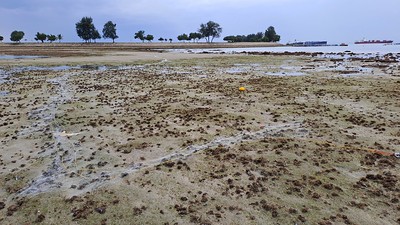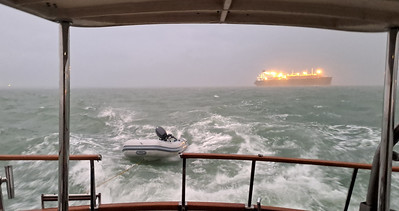Unfortunately, we encountered an abandoned net with 14 dead sharks, an expansion of the field of horse mussels, and sightings of bleaching anemones and pale corals.
An approximately 300m-long fishing net was seen on Pulau Semakau (South) close to the Barammundi Asia fish farm there. 14 Blacktip reef sharks were trapped and killed. One of them was about 1m long, the rest was about 50cm long. There was also one uncommonly seen stingray, possibly a Honeycomb whipray (Himantura uarnak). As well as other small fishes, crabs and hermit crabs. Full photos on flickr. The net was clean and looked freshly laid possibly at the most recent high tide some hours ago.
Here's a map of the area where the net was found. Abandoned nets have been seen in the area in the past. More details on the Project Driftnet blog.More photos of the fishes found in the net by Marcus Ng
There has never been a lot of hard corals on this shore. Many of the large coral colonies showed signs of stress - pale or pinkish patches/sections. Almost all the Cauliflower corals I saw had half or more of the colony dead. But there were healthy Anemone corals, the usual common boulder shaped corals. I also small clumps of Branching montipora coral. But I didn't see mass coral bleaching.
I saw a few medium sized Leathery soft corals of various kinds. They all seemed alright.
We were at Semakau for an anemone hunt and the experts found some in the mangroves! These are the original mangroves from the original Pulau Semakau. Although some of the trees at the seaward edge have died, the lovely little Tengar putih is still alright.
We saw the common sea anemones that are usually abundant here: Fire anemones, Frilly anemones, as well as Upsidedown jellyfish. Also lots of Giant carpet anemones - some of which were bleaching - oh dear. And we saw one Sea mat zoanthid that seemed diseased, with grey rotting flesh.
There has been a large expansion of the area covered by Horse mussel clams from the landfill seawall to the stream opening between the old mangrove and replanted mangroves. This suggests some sort of imbalance in the ecosystem.
I already noticed during our last survey in Dec 2022 that they seem to be spreading out. In Jan 2020 and Mar 2019, I saw them in small groups of less than 10, spread apart. In Oct 2020, there were a lot more and closer together. Covering an area of about 20m2. The situation was similar in Jan 2022. The area is opposite Barramundi Asia fish farm and most of the mussels were very much alive.
There were growths of Spoon seagrasses everywhere, with sprinkles of other seagrass species. I didn't see any long Tape seagrass - most remain cropped. This is similar to what we saw in Jan 2022 and Dec 2022.
We were already on the boat when the Sumatras storm hit. It was fierce but brief. Fortunately, the rain and wind eased by the time we arrived.
I saw a few medium sized Leathery soft corals of various kinds. They all seemed alright.
We were at Semakau for an anemone hunt and the experts found some in the mangroves! These are the original mangroves from the original Pulau Semakau. Although some of the trees at the seaward edge have died, the lovely little Tengar putih is still alright.
We saw the common sea anemones that are usually abundant here: Fire anemones, Frilly anemones, as well as Upsidedown jellyfish. Also lots of Giant carpet anemones - some of which were bleaching - oh dear. And we saw one Sea mat zoanthid that seemed diseased, with grey rotting flesh.
There has been a large expansion of the area covered by Horse mussel clams from the landfill seawall to the stream opening between the old mangrove and replanted mangroves. This suggests some sort of imbalance in the ecosystem.
I already noticed during our last survey in Dec 2022 that they seem to be spreading out. In Jan 2020 and Mar 2019, I saw them in small groups of less than 10, spread apart. In Oct 2020, there were a lot more and closer together. Covering an area of about 20m2. The situation was similar in Jan 2022. The area is opposite Barramundi Asia fish farm and most of the mussels were very much alive.
There were growths of Spoon seagrasses everywhere, with sprinkles of other seagrass species. I didn't see any long Tape seagrass - most remain cropped. This is similar to what we saw in Jan 2022 and Dec 2022.
As usual, we have a closer look at Barramundi Asia, which claims to be Singapore's biggest fish farm. The barge where things are stored out of sight from land, there was a huge pile of stinking nets, even bigger pile than on our last surveys in Dec 2022 and Jan 2020. Thanks to Marcus for taking the photo of the barge.
 |
| Photos by Marcus Ng |
We were already on the boat when the Sumatras storm hit. It was fierce but brief. Fortunately, the rain and wind eased by the time we arrived.
More about Pulau Semakau
It is NOT true that the construction of the Landfill created the marine life found on Pulau Semakau. The marine life was there long before the Landfill was built.
Just as Changi Airport and Changi Beach are not the same even though they are near one another and share a name, Pulau Semakau is NOT the same as the Semakau Landfill. The Landfill was created by destroying all of Pulau Saking, and about half of the original Pulau Semakau by building a very long seawall. Fortunately, the landfill was constructed and is managed in such a way that the original mangroves, seagrass meadows and reefs on Pulau Semakau were allowed to remain.
What is the fate of Pulau Semakau South?
These shores slated for massive reclamation outlined recently in the Long-Term Plan Review.
The Singapore Blue Plan 2018
Pulau Semakau and nearby islands and submerged reefs have been recommended by the Singapore Blue Plan 2018 for Immediate Conservation Priority. The Blue Plan recommends the intertidal and subtidal marine areas of Pulau Semakau and adjacent Pulau Hantu, and Pulau Jong to be designated Marine Reserve.
The Blue Plan highlights that Pulau Semakau and its associated patch reefs comprise many ecosystems: coral reefs, mangrove areas, intertidal sandflats, seagrass meadows, and coral reefs. The subtidal area of Pulau Jong is larger than the terrestrial area. Pulau Hantu is a popular dive site has seen increasing interest in the past decade due to biodiversity awareness. If protection is accorded to these three islands, zonation plans for use can be implemented to manage tourism and human impacts.
DOWNLOAD the Plan, SUPPORT the Plan! More on the Singapore Blue Plan 2018 site.
More photos by Marcus Ng















